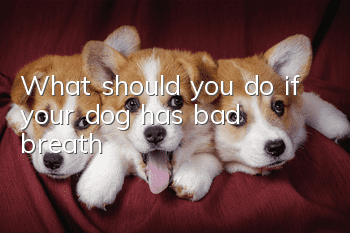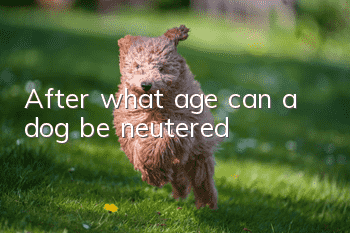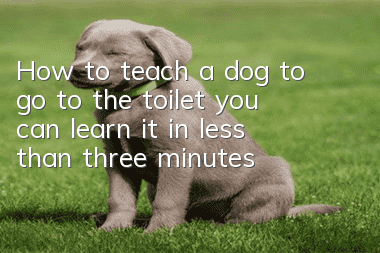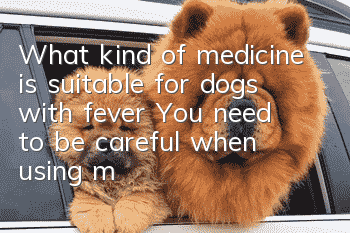What should you do if your dog has bad breath?

"According to the American Veterinary Medical Association, periodontal disease and gum disease are the main causes of bad breath in dogs. 80% of dogs and 70% of cats will have some gum problems before the age of two. Oral bacteria adhere Plaque forms on the surface of the teeth, and when the plaque hardens, tartar is produced, which spreads underneath the gums, causing gum problems and even tooth loss.
Today let’s take a look at some ways to help dogs reduce bad breath.
1. Food selection
Because dogs are omnivorous animals and mainly focus on carnivore. After eating, food residues are left between the teeth, which will cause a bad smell in the mouth.
1. Dry dog food
Daily eating habits also have an impact on teeth. Generally speaking, dry dog food is better than wet dog food (canned). Wet dog food can easily cause tartar to accumulate on the teeth, while dry food is harder and crunchier. Dogs chew dry food. You can also scrape the tooth surface cleanly.
Some owners are used to leaving dog food there all day, and the dog can eat it whenever he wants. In fact, this is not good, because the bacteria in the mouth will be more active every time he eats. If you feed it twice a day regularly, times, then relatively speaking the bacteria will only be active twice.
2. Vegetables and fruits
Remember to regularly feed fresh vegetables and fruits that are rich in vitamins and high fiber. They can rub the tooth surface when chewing and help keep the mouth clean. Many owners feel distressed when their dogs eat very slowly, so they only feed them soft meat. In fact, dogs' teeth need to be sharpened regularly, which will harm the dog. In addition to dog food, add some special dog food and chewing gum such as rough and crisp dog biscuits, which can rub the tooth surface when chewing. Such food is not only beneficial to the dog's body, but also very helpful for oral hygiene.
2. Brush teeth and deodorize
【Specific method:】
1. Scrub the mouth
Take a gauze strip dipped in some saline solution and wrap it around your index finger, then wipe the gums and between the teeth in sequence, doing so gently to avoid damaging the gums.
2. Brush your teeth
After the dog adapts, use a special pet toothbrush dipped in some pet toothpaste to brush its teeth. The specific brushing method is similar to human brushing. Clean the teeth one by one along the gaps between the teeth and massage the gums. If you can't buy a dog-specific toothbrush, a soft-bristle toothbrush for children will work. But never use human toothpaste to brush your dog's teeth. The taste of human toothpaste is very irritating to dogs and can cause discomfort in their digestive system.
Some pet-specific toothpastes are designed for dogs with their favorite flavors, including chicken, beef and other flavors, so that although the dog may not be used to it when he starts brushing, he will not be too repulsed. Brushing your dog's teeth is a step-by-step process, so don't rush or think about getting it right in one step.
Generally, many dogs don't like brushing their teeth, so we'd better try a small gauze to gently rub their teeth when they are a few months old, so that they can slowly get used to it, and then switch to a small toothbrush specifically for dogs. , after the necessary daily care is done, all dog owners should also take your dog to the veterinarian regularly (once or twice a year) for professional teeth cleaning.
3. Clean teeth and deodorize snacks
Teething sticks can help dogs change teeth faster. As for the front canine and deciduous teeth, there is no need to rush to remove them. Try playing more tug-of-war games with your dog. This will also speed up the time it takes for him to lose his canine teeth, and the latter’s permanent teeth have already been fixed. , parents must clean their dog’s teeth at least once a week.
Of course, you can use the method mentioned above. In addition, you can also use dog-specific tooth cleaners (including toothpaste and tooth cleaning spray). It is up to the parents to decide on their own.
4. Medical deodorization
If you have unbearable bad breath, your dog may be suffering from oral inflammation, gingivitis, periodontitis or gastrointestinal disease. This requires going to the hospital for treatment. Take it to a veterinarian to check whether there is dental calculus or excessive tartar, and the mouth needs to be cleaned to improve it. Sometimes bad breath in dogs can be caused by indigestion or internal problems. If you find that your dog has lost weight, increased drinking and urination, vomiting, abdominal swelling, anorexia and other abnormal phenomena, it may be caused by liver or kidney problems. The problem may also be diabetes, and you should take it to the veterinarian for diagnosis and treatment as soon as possible.
- When should puppies be vaccinated?
- How to keep your pet dog healthy
- How to choose dog food for senior dogs
- Instructions and precautions for using external insect repellent drops for dogs
- My puppy seems to have something in his throat and keeps retching. What's going on?
- What are the symptoms of puppy poisoning?
- What's the matter with dogs not getting fat after eating?
- Dog keeps panting rapidly
- What to do if a dog swallows a foreign object
- Bichon Frize training tips, poop shovelers should keep them in mind!



